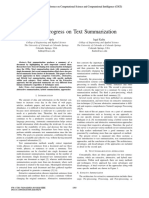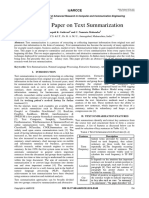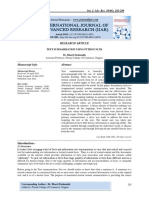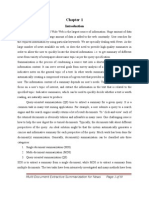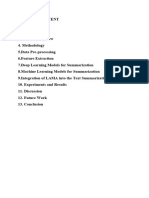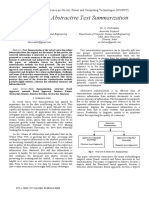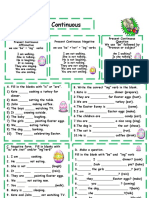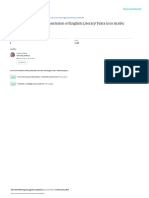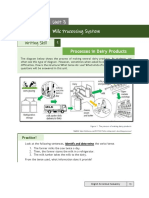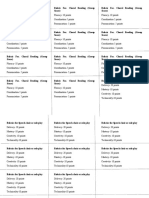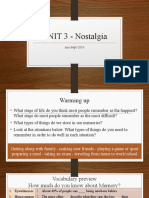Arabic Text Summarization
Introduction
In the 1950s, the Third Industrial Revolution emerged, represented by the digital
revolution. With the availability of the internet worldwide, its impact on global
industries has continued to this day. This digital transformation has led to an
unprecedented explosion of information, with vast amounts of data being generated
every second.
As a result, efficiently processing and summarizing large volumes of text has become
essential, especially for languages like Arabic, which has complex linguistic structures.
The rise of artificial intelligence and natural language processing (NLP) has enabled
significant advancements in Arabic text summarization, allowing for the extraction of
key information from massive datasets. These developments are crucial in various fields,
such as journalism, research, and business, where quick and accurate summaries help
users navigate the overwhelming flow of information.
There are more than 7,000 languages spoken worldwide. Arabic is one of the oldest and
most widely spoken languages. It is the official language in more than 26 countries and
is spoken by over 400 million people around the world. Arabic is also a highly descriptive
language, with each word carrying multiple meanings depending on the context. This
richness stems from the complexity of its morphological and syntactical structures.
Classification of Automatic Text Summarization Systems
Automatic Text summarization (ATS) systems are categorized based on specific criteria,
and this section explores different classification approaches in automatic text
summarization.
Classification based on Method: Extractive, Abstractive, or Hybrid. Extractive
summarization selects and displays the most vital sentences from the original text [1]. It
relies on scoring mechanisms to determine sentence importance, ranking them
accordingly. The selected sentences are then reordered to maintain coherence, preserving
the original text without generating new sentences. Abstractive summarization, in
contrast, generates a summary by rephrasing or using new words rather than merely
extracting key sentences [2]. It aims to perform a deep analysis of the original text and
comprehend the input using semantic information or deep learning techniques. This
approach mimics the way humans summarize information by paraphrasing and
reinterpreting the content. However, generating such summaries is a challenging task
due to the limited availability of high-quality datasets. Hybrid summarization integrates
both extractive and abstractive summarization approaches to generate more coherent
and informative summaries. It aims to leverage the strengths of both approaches while
minimizing their weaknesses. This helps preserve context, enhance readability, and
reduce redundancy in sentences, ensuring a balance between conciseness and
coverage.
Classification based on Output Type: Generic or Query-Based. Generic summarization aims
to produce a summary that is independent of specific readers, striving to be useful and
relevant to a broad audience [4]. It aims to capture the main ideas of the input text
without any bias. It helps recap the key points of a long summary, making it useful for
understanding the topic in general. Query-based summarization is a technique that
generates a summary based on a specific user query or focuses on a particular concept
in the original text. It helps users quickly find specific information without reading the
entire text.
Classification based on Input Type: Single-document, Multi-document. Single-document
Summarization (SDS) generates a concise summary from a single input document while
preserving its key information. This approach helps users save time and produces a
short, meaningful summary[5]. Multi-document Summarization (MDS) generates a
concise summary from a collection of multiple input documents. It aims to produce a
coherent and comprehensive summary while reducing redundancy by removing
duplicate or overlapping content[5]. This approach is more complex than single-
document summarization.
[1] Ferreira, R., De Souza Cabral, L., Lins, R. D., Pereira e Silva, G., Freitas, F., Cavalcanti,
G. D., Lima, R., Simske, S. J., & Favaro, L. (2013). Assessing sentence scoring techniques
for extractive text summarization. Expert Systems With Applications, 40(14), 5755-5764.
https://doi.org/10.1016/j.eswa.2013.04.023
[2] Gupta, S., & Gupta, S. K. (2019). Abstractive summarization: An overview of the state
of the art. Expert Systems With Applications, 121, 49-65.
https://doi.org/10.1016/j.eswa.2018.12.011
[3] Muniraj, P., Sabarmathi, K., Leelavathi, R., & Balaji B, S. (2022). HNTSumm: Hybrid
text summarization of transliterated news articles. International Journal of Intelligent
Networks, 4, 53-61. https://doi.org/10.1016/j.ijin.2023.03.00
[4] Dernoncourt, Franck, Mohammad Ghassemi, and Walter Chang. "A repository of
corpora for summarization." Proceedings of the eleventh international conference on
language resources and evaluation (LREC 2018). 2018.
[5] Joshi, Monika, Hui Wang, and Sally McClean. "Dense semantic graph and its
application in single document summarisation." Emerging ideas on information filtering
and retrieval: DART 2013: Revised and invited papers (2018): 55-67.
